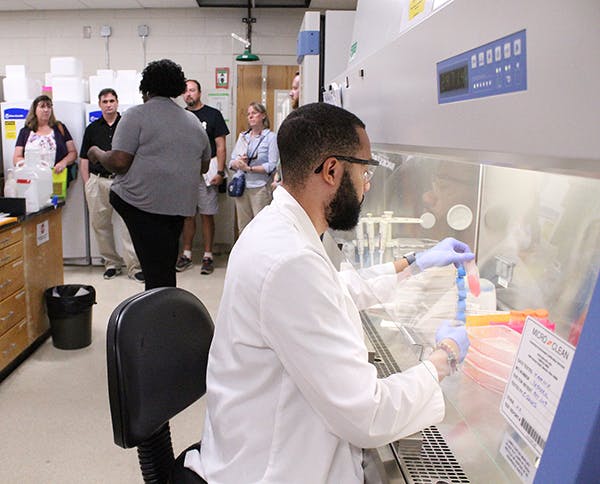A partnership of scientists from across the United States is tackling cancer not from a health care perspective but from an engineering standpoint.
Using manufacturing models and scalable technologies, this $20 million National Science Foundation-funded effort, with $3 million sub-awarded to the University of Georgia, is developing the technology to infuse T-cells with a virus that attacks cancer cells from inside the body. Called the Center for Cell Manufacturing Technologies, or CMaT, the project is working to increase the quality, scalability and ability to transport these specialized treatments to increase access to the new technology.
 CMaT is a key component of an emerging field called bio-engineering. It's cutting-edge and growing, and it needs a workforce to match.
CMaT is a key component of an emerging field called bio-engineering. It's cutting-edge and growing, and it needs a workforce to match.
Cory Buxton, a professor in the UGA College of Education, is here to help. Buxton is working on the educational component of CMaT to create programs and curriculum that can reach kids starting in elementary school, up to high school, technical college and college students.
"I'm the co-director of the workforce development team," said Buxton. This team includes the Georgia Institute of Technology, UGA, the University of Wisconsin-Madison and the University of Puerto Rico-Mayaguez. "Together we're developing education and workforce training at all levels."
For example, in elementary schools, students might get a lesson about cells and learn how changes to them can help your body fight off cancer. At the university level, Buxton says, it could be a module inserted into a core biology or engineering class to introduce freshmen and underrepresented students in STEM fields to the concept of cell or tissue manufacturing. At UGA, which has a master's degree in bio-engineering, this seed planted early in someone's college career could turn them on to an advanced degree.
"Another piece is technical colleges. You don't necessarily need a bachelor's degree to get started in some of these new biotech industries," added Buxton. Many technical colleges, including in Athens, Gwinnett and Atlanta, have bioengineering tracks. "So we talk a lot with high school kids about technical college pathways."
Buxton is also helping to put boots on the ground—or, more precisely, in the labs—where students and teachers can serve as ambassadors for the field. This aspect of the project takes place in three ways: undergraduate students spend a summer working in a lab at one of four partner universities involved with the grant to learn research skills; middle and high school teachers work for a summer in other partner labs and develop curriculum materials they can bring back to their classroom based on their experience; and technical college students and teachers are paired to learn and work together at other labs, where they will take part in more bio-engineering work.
Recently, Buxton welcomed a group of middle and high school teachers from Clarke and Hall counties in Georgia to tour UGA labs for ideas to take back to their classrooms. In addition to working on lesson plans, the group also learned first-hand from professors, such as Cheryl Gomillion, about how cell manufacturing is used.
The idea to create a research center to tackle various levels of cell manufacturing began three years ago at Georgia Tech, when a group of researchers realized that there were few standards to guide this emerging field of bio-engineering. The grant-funded project aims to correct that, crafting a road map for the cell manufacturing process.
UGA received a sub-award of the Georgia Tech grant. Steven Stice, professor, senior research scientist and eminent scholar in the College of Agricultural and Environmental Sciences, is the principal investigator on the grant sub-award.
Hopefully, adds Buxton, the project will not only expose more young adults to a growing, innovative field, but it will also help science teachers recognize an aspect of their lessons that are typically forgotten.
That's because while science teachers love talking about science, they dedicate little class time to discussing the careers that are possible within the field. "I don't think we do enough to talk about the broad range and evolving nature of science careers in science education," he said. This grant, he added, begins to address that.
